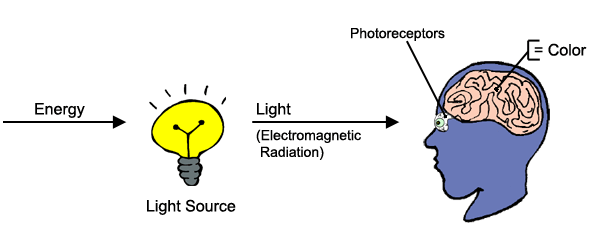Colors of the Rainbow
Color Vision
Color Properties / Terminology
Color Luminance
The Color Wheel
Color Space and Gamut
Multi Model Color Blender
Color Converter
HSL Color Schemer
Colors by Name
1-2-3 Image Resizer
Black & White Picture Converter
Sepia Tone Picture Converter
Gray Card
Colors of the Rainbow



The rainbow is a beautiful, natural phenomenon which continues to inspire people in many ways. The colors of the rainbow are perceived as a set of hues arranged in a specific order. To better remember this order, simply remember the name Roy G. Biv which consists of the first letters of each hue. The seven colors are red, orange, yellow, green, blue, indigo and violet. This is the order from the outside-in of the rainbow's arch. In general, rainbow colors represent diversity and acceptance.
Water Drops Reflect Light
We see a rainbow when rain is in front of us and the sun is located on the opposite side behind us. In this constellation some light of the sun is reflected back to us by raindrops. Light hitting a raindrop also gets bent/refracted at the raindrop's surface and splits up by wavelength. So the reflected light we perceive is not "one ray of white" light anymore but multiple rays of light with distinct wavelength. In "reality" the colors of the rainbow consist of the whole light-color-spectrum but our visual system forms the distinctive bands. The rainbow is partly transparent because some light isn't reflected, but can pass through the raindrops instead.
Color, Light and Energy
The rainbow inspired scientists to further explore the
nature of
The following scheme illustrates the relationship between
color, light and energy.

Can you find the two missing links in the relationship
between color, light and energy? Yes, more precisely you'd
have to say there's a relationship between color, a light
processing system, light, a light emitting system and energy.
In this section the light emitting system (light source) is of interest
to us because it can influence two properties of light which
then make the input for the light processing system.
Light Properties
![]() Light is a form of electromagnetic radiation and the word
radiation implies that light travels in waves.
Light is a form of electromagnetic radiation and the word
radiation implies that light travels in waves.
![]() The light waves have interruptions though. This is why
we say that a light ray consists of wave-packets, called
photons.
The light waves have interruptions though. This is why
we say that a light ray consists of wave-packets, called
photons.
 Now, the light source, for one, can influence the
Now, the light source, for one, can influence the
Let's look at a wavelength equation to see how a light source
uses energy to influence wavelength.

This means we can formulate the relationship:
 The more energy is used for one photon, the smaller the wavelength of light.
Since frequency is inversely proportional to wavelength you can also say:
The more energy is used for one photon, the higher the frequency of light.
The more energy is used for one photon, the smaller the wavelength of light.
Since frequency is inversely proportional to wavelength you can also say:
The more energy is used for one photon, the higher the frequency of light.
Let's look at a Number of Photons equation to see how a light source
uses energy to influence the number of photons.

This means we can formulate the relationship:
Under the assumption a light source keeps the wavelength constant:
The more energy is used, the more photons are emitted (increasing intensity).
A light source can have the ability to change wavelength and number
of photons at the same time. Can a light source also change properties
of light, if energy input stays constant? What would happen with either property?
A rearrangement of the above formula simplifies finding the answers:

This means we can formulate the relationship:
Under the assumption a light source keeps total energy constant:
The more photons are emitted, the higher their wavelength.
Color Spectrum: Visible Range of Wavelength
The range of wavelength where em-radiation is defined as
visible light
is approximately between 400nm to 700nm, where one nanometer (nm)
equals to 0.000 001 millimeters.
Shorter wavelength (more energy) radiation is called ultraviolet. Longer
wavelength (less energy) radiation is called infrared.
A light processing system uses wavelength to differentiate hues (red,
orange, yellow... ). It transforms wavelength into a certain hue value.
We can visualize this transformation for the visible range of wavelength
by drawing a color spectrum chart.

In the next section we explore the human light processing system.